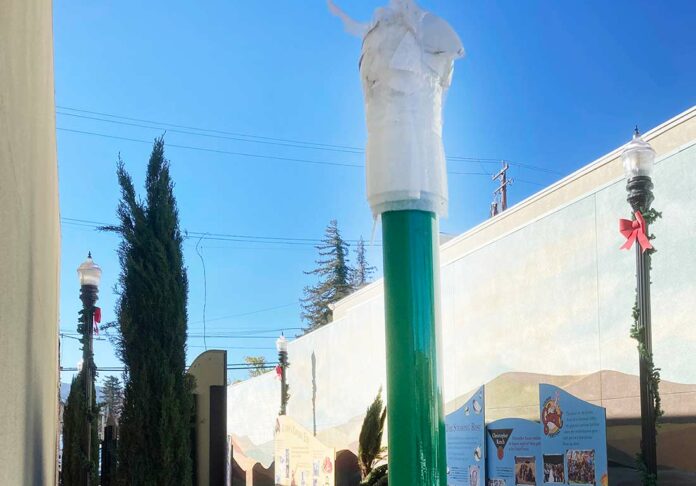
A replica bell approved more than a year ago for downtown Gilroy faces opposition from the Amah Mutsun Tribal Band, who say such markers symbolize enslavement of Native Americans during the Spanish colonization period.
Those in support of the bell, however, say it does not represent the violent practices of the Catholic missions, but rather, pays homage to the historic El Camino Real route.
The bell and a plaque was approved by the Gilroy City Council in September 2020, after an earlier 6-1 recommendation by the Arts and Culture Commission.
The commemorative marker was brought forth by Gilroy’s 150th anniversary committee as a way to recognize the city’s sesquicentennial in 2020. The bell is slated to be placed in the paseo on Monterey Street between Sixth and Fifth streets.
Currently, only the pole has been installed.
Nine people spoke out against the bell during the council’s Jan. 10 meeting, urging the governing body to retract its earlier approval. The council also received more than 40 emailed letters in opposition before the meeting, including from the Amah Mutsun Tribal Band, ACLU of Northern California and Indian Health Center of Santa Clara Valley.
The Amah Mutsun say the El Camino Real bell markers, which can be found along Highway 101 and elsewhere, “celebrate a white-washed, romanticized and distorted history that has long been promoted in the state.”
In a letter to the council, Valentin Lopez, chairman of the Amah Mutsun Tribal Band, wrote that the bells “have long served to erase the true history and experiences of California’s tribal peoples who suffered so many atrocities during the deadly times of Spanish occupation and internment in the mission system.”
“The mission bell was used by missionaries in the Spanish missions to regiment a daily schedule of mandatory prayer and compulsory labor,” he wrote.
The City of Santa Cruz, Lopez noted, agreed to remove all El Camino Real bell markers in 2020, and held a ceremony in August 2021 commemorating the final bell’s removal.
Because the item was not on the agenda, the council did not discuss the bell.
Councilmember Rebeca Armendariz, however, requested the bell be brought back at a future meeting for discussion. The motion failed, with only herself and Councilmembers Zach Hilton and Fred Tovar supporting it.
After the meeting, Lopez said it felt like the majority of the council “did not even consider our words and all of the community input that they received on this issue.”
“We are extremely disappointed with the City of Gilroy for refusing to even have a public discussion regarding our tribe’s request to reconsider the planned El Camino Real bell installation,” he said. “The city has shown great disrespect to our tribe by refusing to engage with us regarding the bell, and by not consulting with us to begin with regarding the installation of the El Camino Real bell and the interpretation of our tribal history at the Gilroy Historical Paseo project.”
Mayor Marie Blankley said after the meeting that the bell has already received its approval from two city bodies, as well as two rounds of public hearings.
“Through public comment and commissioner deliberations, the Arts & Culture Commission recommended approval of the bell to the City Council, where it withstood another public hearing before being unanimously approved,” she said.
The El Camino Real bells, she said, were guideposts along the historic route, and replicas can be found throughout the state that mark its location.
A plaque will be installed with the bell, which will read, “Located at the intersection of historic pathways of native peoples and El Camino Real, Gilroy’s location has long been the key to its good fortune. In 1906, guidepost bells were placed along the El Camino Real to guide early travelers and preserve the historic route. Today El Camino Real is known as Monterey Highway.”













